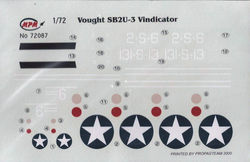MPM
1/72-SCALE DECALS-ONLY VOUGHT SB2U VINDICATOR CARRIER DIVE BOMBER WW2 USMC
VMSB-131 VMSB -2 VMSB-241 USN
---------------------------
Additional Information from
Internet Encyclopedia
The Vought SB2U Vindicator is an
American carrier-based dive bomber developed for the United States Navy in the
1930s, the first monoplane in this role. Vindicators still remained in service
at the time of the Battle of Midway, but by 1943, all had been withdrawn to
training units. It was known as the Chesapeake in Royal Navy service.
Design and development
In 1934, the United States Navy
issued a requirement for a new Scout Bomber for carrier use, and received
proposals from six manufacturers. The specification was issued in two parts,
one for a monoplane, and one for a biplane. Vought submitted designs in both
categories, which would become the XSB2U-1 and XSB3U-1 respectively. The
biplane was considered alongside the monoplane design as a "hedge"
against the U.S. Navy's reluctance to pursue the modern configuration.
The XSB2U-1 was of conventional
low-wing monoplane configuration with a retractable conventional tailwheel
landing gear, the pilot and tail gunner being seated in tandem under a long
greenhouse-style canopy. The fuselage was of steel tube construction, covered
with aluminum panels from the nose to the rear cockpit with a fabric-covered
rear fuselage, while the folding cantilever wing was of all-metal construction.
A Pratt & Whitney R-1535 Twin-Wasp Junior radial engine drove a two-blade
constant-speed propeller, which was intended to act as a dive brake during a
dive bombing attack. The use of propeller braking was not entirely successful,
and in practice US Navy Vindicators lowered the aircraft's undercarriage to act
as a speed brake and dived at shallower angles. A single 1,000 lb (450 kg) bomb
could be carried on a swinging trapeze to allow it to clear the propeller in a
steep dive, while further bombs could be carried under the wings to give a
maximum bombload of 1,500 lb (680 kg).
The SB2U was evaluated against
the Brewster XSBA-1, Curtiss XSBC-3, Great Lakes XB2G-1, Grumman XSBF-1 and
Northrop XBT-1. All but the Great Lakes and Grumman submissions were ordered
into production. Designated XSB2U-1, one prototype was ordered on 15 October
1934 and was delivered on 15 April 1936. Accepted for operational evaluation on
2 July 1936, the prototype XSB2U-1, BuNo 9725, crashed on 20 August 1936.[4]
Its successful completion of trials led to further orders,[1] with 56 SB2U-1s
ordered on 26 October 1936,[5] and a further 58 of a slightly modified version,
the SB2U-2, on 6 October 1938.
The SB2U-3 was a more heavily
modified version, intended as a long-range scout bomber, capable of being
fitted with a conventional wheeled undercarriage, for operations from aircraft
carriers or land airbases, or with floats. To give the required increased
range, the fuselage fuel tank fitted to the SB2U-1 and -2 was supplemented by
integral wing tanks, while the aircraft's tail had an increased span. The
prototype XSB2U-3, converted from the last SB2U-1, flew in February 1939, and
after testing as both a landplane and floatplane, 57 SB2U-3s were ordered on 25
September 1939, mainly for the US Marine Corps.
The SB2U is prominently featured
in the 1941 film Dive Bomber.
There were 260 examples of all
Vindicator variants produced, and a single example is preserved at the National
Naval Aviation Museum at NAS Pensacola, Florida.
Deliveries to the US Navy began
in December 1937, when four aircraft joined VB-3 aboard the aircraft carrier
Saratoga, replacing Curtiss BFC-2 biplanes. As well as Saratoga, Vindicators
served on the carriers Lexington, Ranger, and Wasp. Air Group Nine, destined
for Essex, trained in Vindicators aboard the escort carrier Charger, but they
transitioned to the Douglas SBD Dauntless before Essex joined the war.
During the attack on Pearl
Harbor, seven Vindicators from the U.S. squadron VMSB-231 were destroyed at Ewa
Field
U.S. Marine Corps
VMSB-131
and VMSB-241 were the only two USMC squadrons that fielded the Marine-specific
SB2U-3 between March 1941 and September 1943. VMSB-241's Vindicators saw combat
at the Battle of Midway in June 1942. Airmen with experience in more modern
aircraft spoke disparagingly of SB2Us as "vibrators" or "wind
indicators" in their later combat assignments. Captain Richard E. Fleming
piloted a SB2U-3 Vindicator in an attack on the Japanese cruiser Mikuma on 5
June 1942, for which he was posthumously awarded the Medal of Honor.





